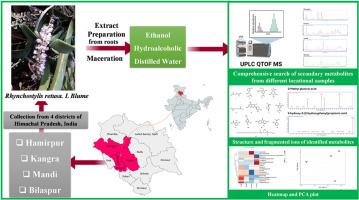基于UHPLC-Q-TOF-IMS的柳条草非靶向代谢组学综合分析L Blume揭示了化学计量学的变化。西喜马拉雅地区的案例研究
IF 2
4区 生物学
Q4 BIOCHEMISTRY & MOLECULAR BIOLOGY
引用次数: 0
摘要
黄纹兰是一种附生药用兰花,原产于热带和亚热带地区,包括西喜马拉雅地区。药理报告显示其具有抗菌、抗炎和抗氧化活性。印度西喜马拉雅地区,特别是喜马偕尔邦,由于其独特的生态条件,已知会影响代谢物的生物合成,为雷杜沙的生长提供了独特的环境。因此,本研究旨在利用UHPLC-Q-TOF-IMS分析不同地理位置白杨根的化学计量学差异。从4个不同产地(Hamirpur、Mandi、Bilaspur和Kangra)的白杨根中鉴定出43种化合物,分别属于多酚类、黄酮类、二苯乙烯类等。此外,由于生态条件的不同,鉴定出的代谢物在不同的地点也有所不同。通过对不同样品的化学计量分析,可以清楚地观察到这些差异。主成分分析和层次聚类分析表明,多酚类物质在不同地点间具有丰富度、相似性和差异性。本文首次报道了黄毛霉代谢产物的综合图谱,为黄毛霉材料的化学成分鉴别和质量评价提供了依据。此外,色谱联用质谱法鉴定出了兔耳草的化学组成,这可能是传统健康益处和报道的治疗活性的关键成分。本文章由计算机程序翻译,如有差异,请以英文原文为准。

Comprehensive UHPLC-Q-TOF-IMS based non-targeted metabolome analysis of Rhynchostylis retusa. L Blume revealed chemometric variations. A case study from Western Himalayas
Rhynchostylis retusa (R. retusa) is an epiphytic medicinal orchid native to tropical and subtropical regions, including Western Himalayas. Pharmacological reports suggested its antimicrobial, anti-inflammatory, and antioxidant activities. Indian western Himalayas, especially Himachal Pradesh, provide a unique environment to grow R. retusa due to distinct ecological conditions, known to influence biosynthesis of metabolites. Thus, this study was focused to find out the chemometric variations using UHPLC-Q-TOF-IMS among differential geographical roots of R. retusa. Comprehensively, R. retusa roots of four distinct locations (Hamirpur, Mandi, Bilaspur and Kangra) revealed the identification of 43 compounds, belonging to polyphenols, flavonoids, stilbenes etc. Further, identified metabolites were found varied at different locations due to the ecological conditions. These variations were clearly observed with chemometric analysis of different samples. The principal component and hierarchical clustering analysis showed abundance of polyphenols, similarities and discrimination, including their metabolites among the locations. This is the first report on the comprehensive metabolite profiling of R. retusa and that will be helpful to differentiate or assess the quality of material based on chemical makeup. Moreover, chromatographic coupled with mass spectrometry identified chemical makeup of R. retusa, that could be the responsible key components of traditional health benefits and reported therapeutic activities.
求助全文
通过发布文献求助,成功后即可免费获取论文全文。
去求助
来源期刊

Biochemical Systematics and Ecology
生物-进化生物学
CiteScore
3.00
自引率
12.50%
发文量
147
审稿时长
43 days
期刊介绍:
Biochemical Systematics and Ecology is devoted to the publication of original papers and reviews, both submitted and invited, in two subject areas: I) the application of biochemistry to problems relating to systematic biology of organisms (biochemical systematics); II) the role of biochemistry in interactions between organisms or between an organism and its environment (biochemical ecology).
In the Biochemical Systematics subject area, comparative studies of the distribution of (secondary) metabolites within a wider taxon (e.g. genus or family) are welcome. Comparative studies, encompassing multiple accessions of each of the taxa within their distribution are particularly encouraged. Welcome are also studies combining classical chemosystematic studies (such as comparative HPLC-MS or GC-MS investigations) with (macro-) molecular phylogenetic studies. Studies that involve the comparative use of compounds to help differentiate among species such as adulterants or substitutes that illustrate the applied use of chemosystematics are welcome. In contrast, studies solely employing macromolecular phylogenetic techniques (gene sequences, RAPD studies etc.) will be considered out of scope. Discouraged are manuscripts that report known or new compounds from a single source taxon without addressing a systematic hypothesis. Also considered out of scope are studies using outdated and hard to reproduce macromolecular techniques such as RAPDs in combination with standard chemosystematic techniques such as GC-FID and GC-MS.
 求助内容:
求助内容: 应助结果提醒方式:
应助结果提醒方式:


